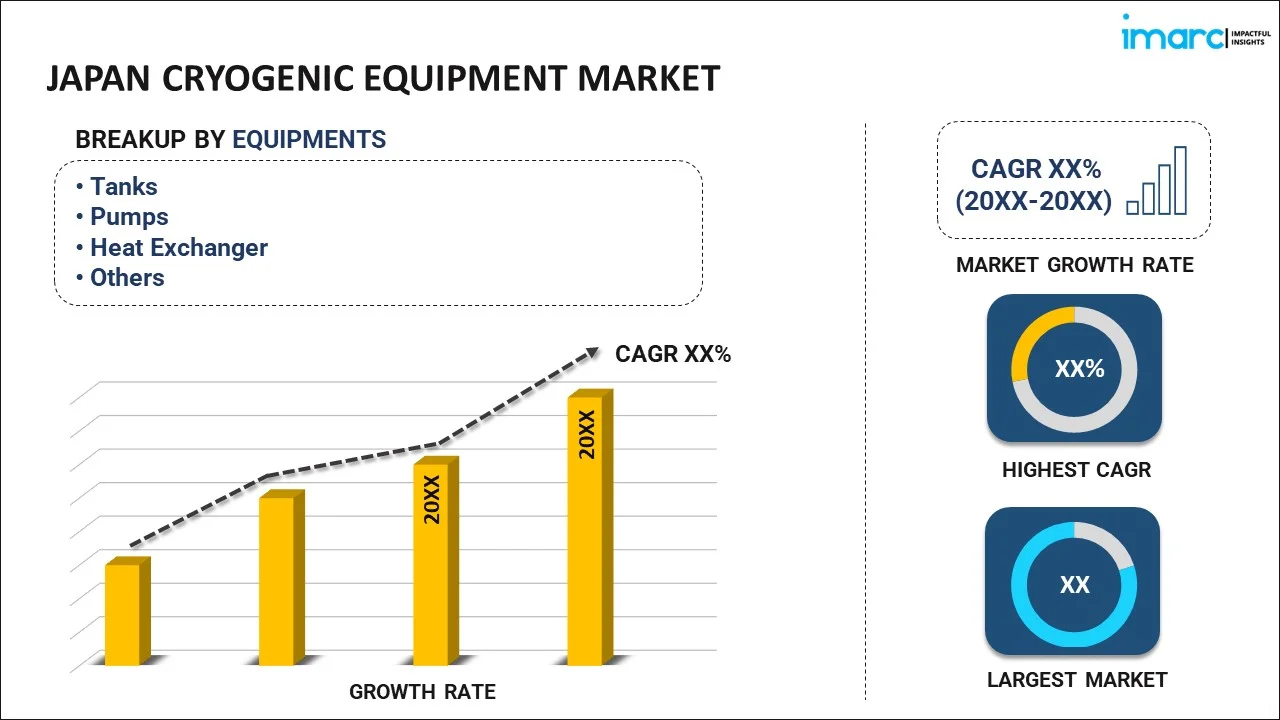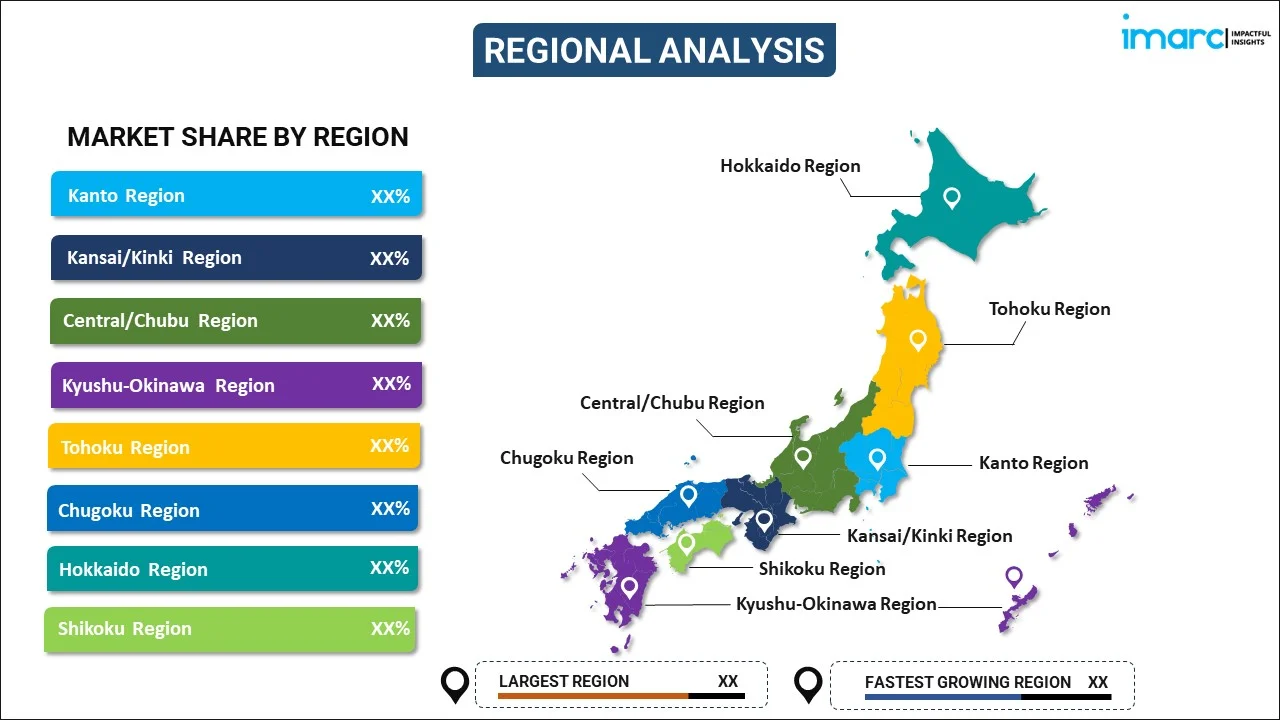
Japan Cryogenic Equipment Market Report by Equipment (Tanks, Pumps, Heat Exchanger, Valves, and Others), Cryogen (Nitrogen, Liquified Natural Gas, Helium, and Others), Application (Storage, Transportation, Processing, and Others), End Use Industry (Oil and Gas, Energy and Power, Food and Beverages, Healthcare, Marine and Aerospace, Chemicals, and Others), and Region 2025-2033
Market Overview:
Japan cryogenic equipment market size reached USD 1.0 Billion in 2024. Looking forward, IMARC Group expects the market to reach USD 1.5 Billion by 2033, exhibiting a growth rate (CAGR) of 3.81% during 2025-2033. The expanding medical and healthcare industry, which relies heavily on cryogenic equipment for applications like cryopreservation, tissue preservation, and medical imaging, is driving the market.
|
Report Attribute
|
Key Statistics
|
|---|---|
|
Base Year
|
2024 |
|
Forecast Years
|
2025-2033
|
|
Historical Years
|
2019-2024
|
| Market Size in 2024 | USD 1.0 Billion |
| Market Forecast in 2033 | USD 1.5 Billion |
| Market Growth Rate (2025-2033) | 3.81% |
Cryogenic equipment is a specialized category of machinery and devices designed to handle extremely low temperatures, typically below -150 degrees Celsius (-238 degrees Fahrenheit). These frigid conditions are necessary for various industrial, scientific, and medical applications. Cryogenic equipment includes components like cryogenic storage tanks, refrigeration systems, and insulated pipelines. One of the most common uses of cryogenic equipment is in the storage and transportation of liquefied gases, such as liquid nitrogen, liquid oxygen, and liquid helium. These gases are crucial in industries like healthcare for medical treatments, aerospace for rocket propulsion, and research for experiments conducted at ultra-low temperatures. Cryogenic equipment must be meticulously engineered to withstand the extreme cold and prevent heat transfer from the surrounding environment. High-quality insulation, specialized materials, and safety features are essential to ensure the reliability and safety of these systems. Overall, cryogenic equipment plays a vital role in facilitating numerous technological advancements and applications that rely on the unique properties of extremely low temperatures.
Japan Cryogenic Equipment Market Trends:
The cryogenic equipment market in Japan is poised for substantial growth in the coming years due to a myriad of compelling drivers. Firstly, the increasing demand for liquefied natural gas (LNG) as an eco-friendly energy source has significantly bolstered the cryogenic equipment sector. Additionally, the burgeoning medical and healthcare industry has created a robust demand for cryogenic equipment, particularly in the storage and transportation of medical gases and biological specimens. Furthermore, the aerospace and defense sectors are also key contributors to the market's growth, as they rely on cryogenic equipment for applications like rocket propulsion and satellite cooling systems. Simultaneously, the expanding adoption of cryogenic technologies in the food and beverage industry for rapid freezing and preservation of perishable goods has further fueled market expansion. Moreover, the regional shift towards renewable energy sources, such as hydrogen, is expected to propel the cryogenic equipment market, as these technologies require cryogenic storage and transport solutions. Lastly, advancements in cryogenic technology, such as improved insulation materials and more energy-efficient systems that help to reduce operational costs and improve overall efficiency, are expected to drive the market in Japan during the forecast period.
Japan Cryogenic Equipment Market Segmentation:
IMARC Group provides an analysis of the key trends in each segment of the market, along with forecasts at the country level for 2025-2033. Our report has categorized the market based on equipment, cryogen, application, and end use industry.
Equipment Insights:

- Tanks
- Pumps
- Heat Exchanger
- Valves
- Others
The report has provided a detailed breakup and analysis of the market based on the equipment. This includes tanks, pumps, heat exchanger, valves, and others.
Cryogen Insights:
- Nitrogen
- Liquified Natural Gas
- Helium
- Others
A detailed breakup and analysis of the market based on the cryogen have also been provided in the report. This includes nitrogen, liquified natural gas, helium, and others.
Application Insights:
- Storage
- Transportation
- Processing
- Others
The report has provided a detailed breakup and analysis of the market based on the application. This includes storage, transportation, processing, and others.
End Use Industry Insights:
- Oil and Gas
- Energy and Power
- Food and Beverages
- Healthcare
- Marine and Aerospace
- Chemicals
- Others
A detailed breakup and analysis of the market based on the end use industry have also been provided in the report. This includes oil and gas, energy and power, food and beverages, healthcare, marine and aerospace, chemicals, and others.
Regional Insights:

- Kanto Region
- Kansai/Kinki Region
- Central/ Chubu Region
- Kyushu-Okinawa Region
- Tohoku Region
- Chugoku Region
- Hokkaido Region
- Shikoku Region
The report has also provided a comprehensive analysis of all the major regional markets, which include Kanto Region, Kansai/Kinki Region, Central/ Chubu Region, Kyushu-Okinawa Region, Tohoku Region, Chugoku Region, Hokkaido Region, and Shikoku Region.
Competitive Landscape:
The market research report has also provided a comprehensive analysis of the competitive landscape. Competitive analysis such as market structure, key player positioning, top winning strategies, competitive dashboard, and company evaluation quadrant has been covered in the report. Also, detailed profiles of all major companies have been provided. Some of the key players include:
- Canon Anelva Inc.
- IHI Corporation
- Japan Chemical Engineering & Machinery Co. Ltd.
- Sumitomo Heavy Industries Ltd.
- Ulvac Inc.
(Please note that this is only a partial list of the key players, and the complete list is provided in the report.)
Japan Cryogenic Equipment Market Report Coverage:
| Report Features | Details |
|---|---|
| Base Year of the Analysis | 2024 |
| Historical Period | 2019-2024 |
| Forecast Period | 2025-2033 |
| Units | Billion USD |
| Scope of the Report | Exploration of Historical Trends and Market Outlook, Industry Catalysts and Challenges, Segment-Wise Historical and Future Market Assessment:
|
| Equipments Covered | Tanks, Pumps, Heat Exchanger, Valves, Others |
| Cryogens Covered | Nitrogen, Liquified Natural Gas, Helium, Others |
| Applications Covered | Storage, Transportation, Processing, Others |
| End Use Industries Covered | Oil and Gas, Energy and Power, Food and Beverages, Healthcare, Marine and Aerospace, Chemicals, Others. |
| Regions Covered | Kanto Region, Kansai/Kinki Region, Central/ Chubu Region, Kyushu-Okinawa Region, Tohoku Region, Chugoku Region, Hokkaido Region, Shikoku Region |
| Companies Covered | Canon Anelva Inc., IHI Corporation, Japan Chemical Engineering & Machinery Co. Ltd., Sumitomo Heavy Industries Ltd., Ulvac Inc., etc. |
| Customization Scope | 10% Free Customization |
| Post-Sale Analyst Support | 10-12 Weeks |
| Delivery Format | PDF and Excel through Email (We can also provide the editable version of the report in PPT/Word format on special request) |
Key Questions Answered in This Report:
- How has the Japan cryogenic equipment market performed so far and how will it perform in the coming years?
- What has been the impact of COVID-19 on the Japan cryogenic equipment market?
- What is the breakup of the Japan cryogenic equipment market on the basis of equipment?
- What is the breakup of the Japan cryogenic equipment market on the basis of cryogen?
- What is the breakup of the Japan cryogenic equipment market on the basis of application?
- What is the breakup of the Japan cryogenic equipment market on the basis of end use industry?
- What are the various stages in the value chain of the Japan cryogenic equipment market?
- What are the key driving factors and challenges in the Japan cryogenic equipment?
- What is the structure of the Japan cryogenic equipment market and who are the key players?
- What is the degree of competition in the Japan cryogenic equipment market?
Key Benefits for Stakeholders:
- IMARC’s industry report offers a comprehensive quantitative analysis of various market segments, historical and current market trends, market forecasts, and dynamics of the Japan cryogenic equipment market from 2019-2033.
- The research report provides the latest information on the market drivers, challenges, and opportunities in the Japan cryogenic equipment market.
- Porter's five forces analysis assist stakeholders in assessing the impact of new entrants, competitive rivalry, supplier power, buyer power, and the threat of substitution. It helps stakeholders to analyze the level of competition within the Japan cryogenic equipment industry and its attractiveness.
- Competitive landscape allows stakeholders to understand their competitive environment and provides an insight into the current positions of key players in the market.
Need more help?
- Speak to our experienced analysts for insights on the current market scenarios.
- Include additional segments and countries to customize the report as per your requirement.
- Gain an unparalleled competitive advantage in your domain by understanding how to utilize the report and positively impacting your operations and revenue.
- For further assistance, please connect with our analysts.
 Inquire Before Buying
Inquire Before Buying
 Speak to an Analyst
Speak to an Analyst
 Request Brochure
Request Brochure
 Request Customization
Request Customization




.webp)




.webp)












